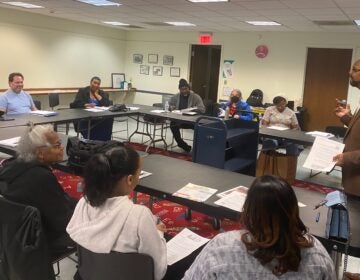Rare remnants of the American Chestnut tree remain in Roxborough
-
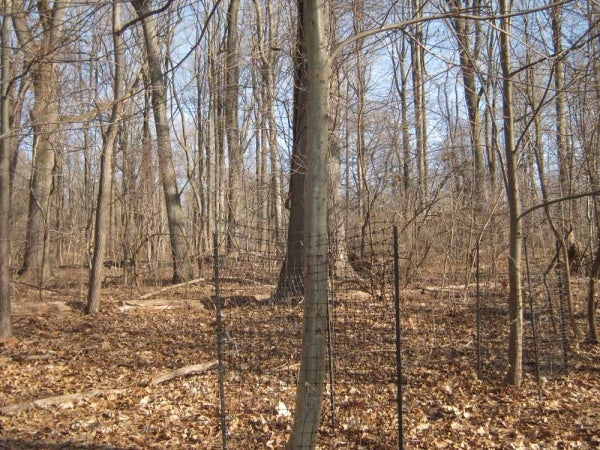
<p>An American Chestnut is protected by fencing to prevent it from contracting fungus through the wounds left by the antlers of running deer. (Alaina Mabaso/for NewsWorks)</p>
-
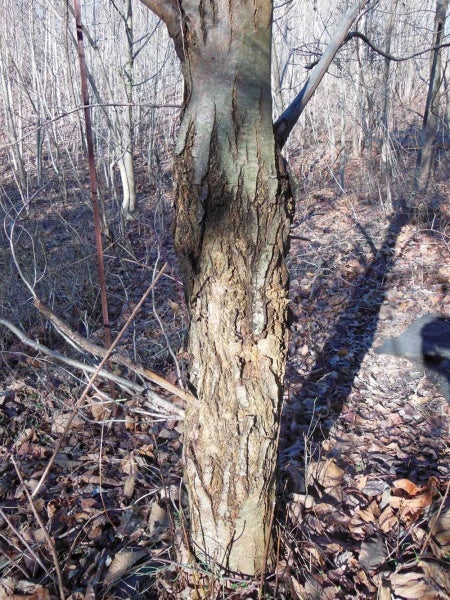
<p>Tree canker can be a symptom of blight. (Alaina Mabaso/for NewsWorks)</p>
-
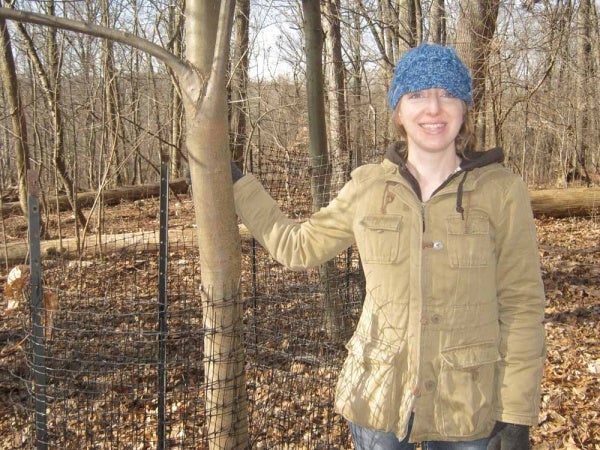
<p>Joanne Donohue, Manager of Land Restoration at the Schuylkill Center for Environmental Education, touches an American Chestnut tree at the site. (Alaina Mabaso/for NewsWorks)</p>
-
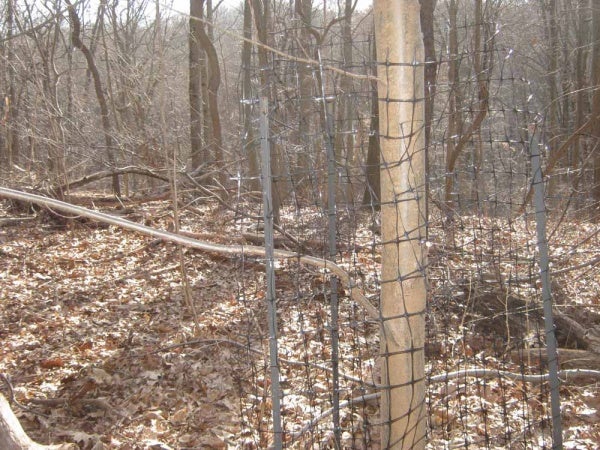
<p>One of the site's Chestnut trees is protected by fencing to prevent it from contracting the fungus through the wounds left by the antlers of rutting deer. (Alaina Mabaso/for NewsWorks)</p>
-
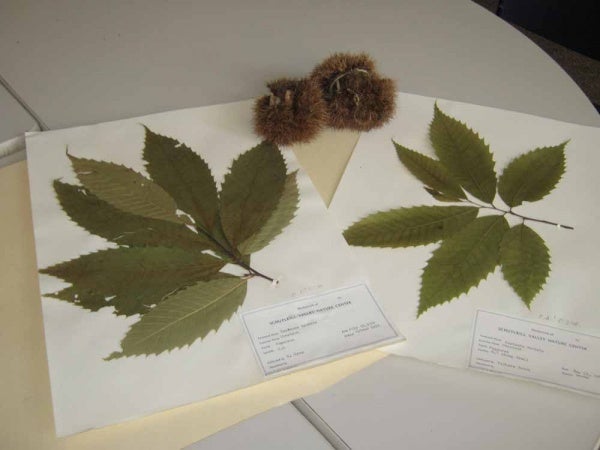
<p>Dried American Chestnut leaves on file at the Schuylkill Center. (Alaina Mabaso/for NewsWorks) </p>
-
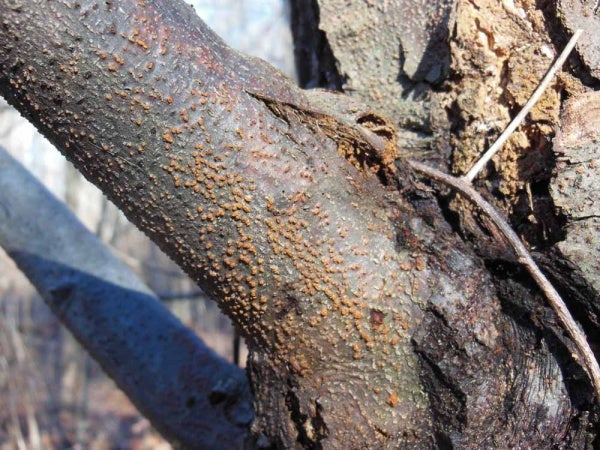
<p>A sign of Chestnut tree blight at the Schuylkill Center for Environmental Education. (Alaina Mabaso/for NewsWorks)</p>
“Oh Chestnut tree, Oh Chestnut tree, I miss your mighty branches,” Dolly Parton croons in a new song released last month. “Promise you’ll return again; I really miss you, mighty friend.”
Up north, the Roxborough forest is doing its part.
Tucked away in the woods surrounding the Schuylkill Center for Environmental Education are a few lonely citizens of a bygone world – when the American Chestnut tree filled the eastern forests from Maine to Florida.
Joanne Donohue, botanist and Manager of Land Restoration at the Center, explains that the American Chestnut was not only one of our most numerous native trees – making up approximately 25 percent of the hardwood forests east of the Mississippi – but also the “most valuable.”
That’s because the fast-growing American Chestnut, with its tall, straight trunk and straight-grained, durable, rot-resistant wood, was ideal for everything from barn rafters to musical instruments. American Chestnut beams laid our railroads and formed our ships’ masts; they were perfect for telephone poles and furniture alike.
In fact, it was commonly said that the American Chestnut held us from the cradle to the grave: cribs and coffins were made from its wood.
And its wood was only one of many gifts, aside from its crucial role in American forests’ ecology. Its protein-packed nuts fattened hogs, fed countless rural families through the winter, and, according to Donohue, were even bartered for other goods as a sort of currency.
Blight strikes
But in the early 20th century, tragedy struck this iconic species – and everyone who relied on it.
While the blight may have appeared as early as the 1890s, possibly introduced through imported ornamental Japanese Chestnuts, it was documented for the first time at the Bronx Zoo in 1904.
“By 1912, all the American Chestnuts in New York City were dead,” Donohue says, and the blight had spread to 10 other states. By 1940, the entire eastern forest looked “drastically different.”
Asian Chestnut varieties (distant cousins of the American Chestnut) evolved alongside the blight for millennia, and suffer only minor cosmetic damage from the airborne fungus, which enters through small wounds in the bark to destroy a tree’s vascular system. But our Chestnut had no genetic defense. In just a few decades, it had all but vanished.
“The fact that it disappeared left a huge hole,” Donohue explains. Species already devastated from the rampant deforestation of the 19th century – from Chestnut-reliant moths to the black bears, grouse, and raccoons who ate the nuts – saw even more of their food and habitat disappear. Today, we can trace the struggling numbers of once-common species like bobcats back to the loss of the Chestnut.
According to Donohue, old-timers who saw the Chestnut’s glory days recall that when the blight spread, it seemed as if a third of the forest had withered and died.
This profoundly impacted the people who relied on the Chestnut for their shelter, food and livelihood, particularly in Appalachia, including Dolly Parton’s childhood home in Tennessee’s Great Smoky Mountains.
The demise of the American Chestnut “probably contributed to the demise of the Appalachian region, and the sustainability of its economy,” Donohue says.
Launching a comeback
Today, the archives at the Schuylkill Center hold a few sheets of paper marked by the renowned Pennsylvania botanist Dr. Edgar Wherry in 1969, when a team of little-known volunteers fanned through the local woods, searching for Chestnut survivors. The pages hold pressed samples of the now-rare leaves.
In 1983, the trees got their first real shot at a comeback with the launch of the North Carolina-based American Chestnut Foundation. By a painstaking, years-long method of selective breeding called “backcrossing,” the Foundation began to pollinate some of our few remaining American trees with flowers from the Chinese Chestnut, which is extremely resistant to the blight.
First, a Chinese tree is crossed with an American one. The resulting nuts are grown into a tree that is tested, six years later, for resistance to the blight. The hardiest trees are selected for a new round of pollination with other American Chestnuts.
This process repeats for at least four cycles over the ensuing decades, and then the resulting trees are crossed with other hybrids from the same experiment. Ultimately, the hope is to re-introduce a tree that retains the characteristics of the American Chestnut – but with the Chinese tree’s blight-resistance.
‘Bringing the American Chestnut back to Philadelphia’
About twelve years ago, the Schuylkill Center launched a partnership with the Foundation, offering new pollen to the program from their own Chinese Chestnut tree.
“Our personal goal was assisting with their breeding program, but also bring[ing] the American Chestnut back to Philadelphia, and back to the Center,” Donohue says.
A local chapter of the Foundation operated a test-grove of back-crossed American Chestnuts in Audubon, Pa., and for about eight years, the Schuylkill Center assisted in the highly specialized pollination efforts and record-keeping.
The Center also received a batch of about 70 “open-pollinated” American Chestnut trees of uncertain heritage to plant in a special onsite educational grove.
But by 2008, all of that grove’s survivors showed symptoms of the blight. At the same time, due to necessary staff and budget cuts, the Center was forced to discontinue the Foundation partnership.
By 2012, every tree in the Schuylkill Center’s Chestnut grove had died of the blight.
But in a surprise twist, the Center may be on the way to succeeding in its original goal.
A few survivors
Of that original donation from the Foundation, “There were too many to put in the grove,” Donohue reveals now.
A very few were scattered deep in the old-growth woods of the property – and, for reasons Donohue can’t explain, “they’re still looking good.”
Now about 12 years old, three of the young trees are a steep ten-minute walk from the Center. Their tall, straight trunks now rise about 30 feet.
Several feet of the trees’ trunks are still protected by a plastic fence – Donohue notes what a disappointment it would be if these trees contracted the fungus through the wounds left by the antlers of rutting deer.
“I don’t see any sign of the blight – there’s no canker,” Donohue says happily. “The other trees in the [Center’s grove] look beat to hell compared with these guys.”
“I would give it a hug if I could,” she adds, reaching past the plastic barrier to touch one of the slender trunks.
Donohue thinks it’s time to get back in touch with the American Chestnut Foundation, which can help determine the exact genetic heritage of these unexpected survivors.
As Dolly Parton sings, “Thank God for second chances.”
WHYY is your source for fact-based, in-depth journalism and information. As a nonprofit organization, we rely on financial support from readers like you. Please give today.


